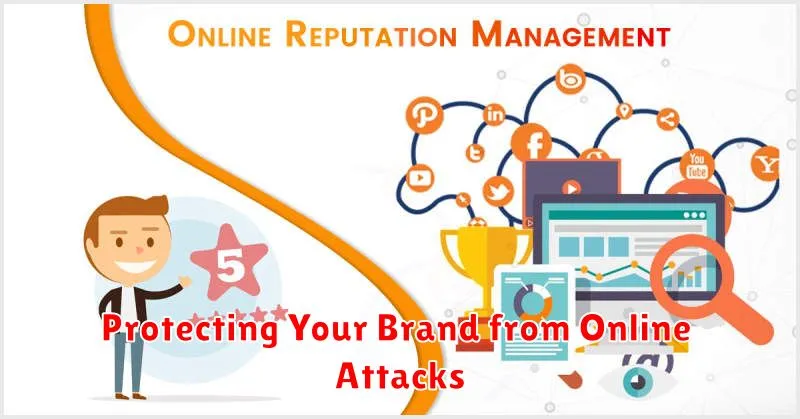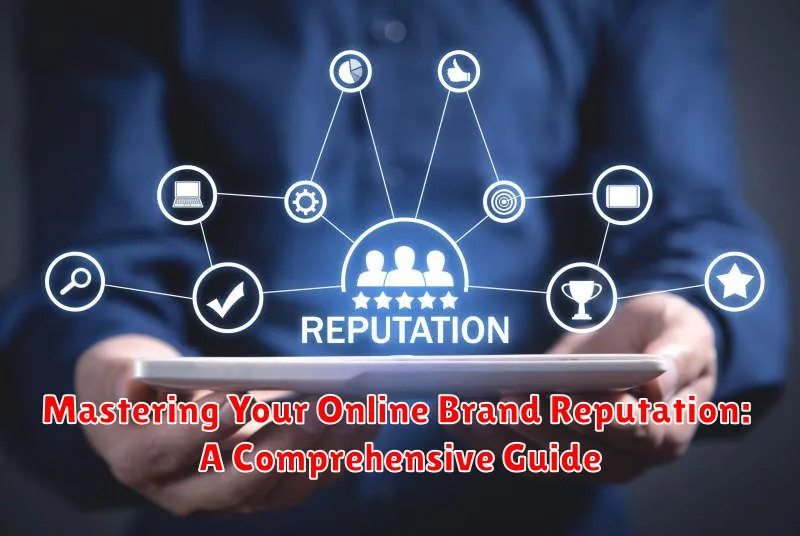In today’s digitally-driven world, your online brand reputation is paramount to success. It is the perception of your brand formed by individuals online, influenced by reviews, social media posts, search engine results, and online interactions. Mastering your online brand reputation is no longer a luxury, but a necessity for businesses and individuals alike. This comprehensive guide provides a deep dive into the strategies and tactics required to cultivate, manage, and protect your online presence, transforming potential risks into opportunities for growth. Learn to monitor, influence, and ultimately, control the narrative surrounding your brand.
Whether you’re an established enterprise, a budding entrepreneur, or an individual seeking to enhance their professional image, understanding the nuances of online reputation management is crucial. This guide will equip you with the knowledge and tools to build a positive online brand reputation, mitigate negative feedback effectively, and leverage your online presence to achieve your goals. From proactive strategies for reputation building to reactive measures for damage control, we’ll cover every aspect of mastering your online brand reputation.
Understanding the Importance of Online Brand Reputation
In today’s digital age, your online brand reputation is paramount to success. It’s the perception of your brand formed by consumers based on their online experiences and interactions. A strong online reputation can significantly impact your business’s bottom line, while a negative one can have devastating consequences.
Consumer Trust: A positive online reputation fosters trust among potential customers. When people see positive reviews and comments about your brand, they are more likely to choose you over competitors. This translates directly into increased sales and revenue.
Brand Loyalty: A consistently positive online presence cultivates brand loyalty. Satisfied customers who share their positive experiences online become brand advocates, attracting new customers and solidifying relationships with existing ones.
Crisis Management: A strong online reputation acts as a buffer during times of crisis. When negative events occur, a history of positive online engagement can help mitigate damage and maintain customer trust.
Talent Acquisition: Your online brand reputation also affects your ability to attract top talent. Prospective employees often research companies online before applying, and a positive reputation can make your business a more desirable place to work.
Monitoring Your Brand Mentions and Reviews

Actively monitoring your brand mentions and reviews is crucial for maintaining a positive online reputation. Knowing what’s being said about your brand, where it’s being said, and the sentiment behind it allows you to address issues promptly and capitalize on positive feedback.
Utilize brand monitoring tools to track mentions across the web, including social media platforms, forums, blogs, and news sites. These tools can provide alerts for new mentions, allowing you to stay informed in real-time.
Set up Google Alerts for your brand name and relevant keywords to receive email notifications whenever your brand is mentioned online. This can be a simple yet effective way to stay aware of online conversations.
Regularly check online review platforms relevant to your industry, such as Yelp, Google Reviews, and TripAdvisor. Pay attention to both positive and negative reviews to understand customer experiences and identify areas for improvement.
Responding to Negative Feedback Effectively
Negative feedback, while undesirable, presents a valuable opportunity to demonstrate your commitment to customer satisfaction and improve your brand’s reputation. Addressing negative comments promptly and professionally is crucial.
Begin by acknowledging the feedback and thanking the individual for sharing their experience. Empathize with their concerns and apologize for any inconvenience or dissatisfaction they experienced. Avoid defensive or dismissive language.
Offer a solution to address the issue raised. This may involve a refund, replacement, or other appropriate action. If the complaint is unfounded, politely explain your perspective without arguing. Take the conversation offline if necessary to gather further information or resolve the issue privately.
Follow up with the individual to ensure their concerns have been addressed to their satisfaction. This demonstrates your commitment to resolving the issue and can turn a negative experience into a positive one.
Building a Positive Online Presence
Cultivating a positive online presence is crucial for building a strong brand reputation. This involves proactively creating and sharing content that showcases your brand’s values, expertise, and commitment to customer satisfaction. Consistency is key. Regularly update your website and social media profiles with engaging and informative content.
High-quality content is paramount. Ensure your website copy is clear, concise, and error-free. Blog posts, articles, and videos should offer valuable insights and establish your brand as a thought leader in your industry. Showcase positive customer testimonials and reviews to build trust and credibility.
Optimize your online presence for search engines. Implement SEO best practices to ensure your brand appears prominently in search results. This includes using relevant keywords, optimizing website content, and building high-quality backlinks.
Leveraging Social Media for Reputation Management
Social media is a powerful tool for managing your online brand reputation. It offers a direct line of communication with your audience and allows you to actively shape the narrative surrounding your brand.
Creating Engaging Content: Sharing valuable and relevant content helps establish your brand as a thought leader and builds a positive image. This can include blog posts, infographics, videos, and engaging discussions.
Active Monitoring and Response: Regularly monitor social media channels for mentions of your brand. Respond promptly and professionally to both positive and negative comments. This demonstrates that you value your customers and their feedback.
Running Targeted Campaigns: Utilize social media advertising to reach a wider audience and promote positive content about your brand. This can help counter negative information and reinforce a positive brand image.
Building a Strong Community: Foster a sense of community by interacting with your followers and encouraging engagement. This builds brand loyalty and creates a network of advocates who can defend your brand against negative attacks.
Engaging with Your Audience and Building Relationships
Engagement is key to building a strong online brand reputation. Actively participating in conversations relevant to your industry and brand helps foster a sense of community and trust.
Respond to comments and questions promptly and thoughtfully. This demonstrates that you value your audience and are attentive to their needs. Personalized interactions can significantly impact how customers perceive your brand.
Creating valuable content that resonates with your target audience is crucial. This could include blog posts, articles, videos, or interactive content. By providing useful information and insights, you position yourself as a thought leader and build credibility.
Hosting online events, Q&A sessions, or webinars can provide opportunities for direct interaction with your audience. These events can foster a sense of connection and provide valuable insights into customer perspectives.
Using Online Review Platforms to Your Advantage
Online review platforms like Yelp, Google My Business, and TripAdvisor are powerful tools that can significantly impact your brand’s reputation. Actively managing your presence on these platforms is crucial for success.
Encourage satisfied customers to leave reviews. A consistent stream of positive reviews builds credibility and attracts new customers. Make it easy for them by providing direct links or instructions.
Respond to all reviews, both positive and negative. Thanking reviewers for positive feedback shows appreciation. Addressing negative reviews publicly demonstrates your commitment to customer satisfaction and provides an opportunity to rectify issues.
Claim and verify your business listings on all relevant platforms. This ensures accuracy and allows you to control the information displayed. Keep your business information updated, including hours of operation, contact details, and services offered.
Monitor reviews regularly to identify trends and areas for improvement. Use feedback to enhance your products, services, or customer experience. Analyze the language used in reviews to understand customer sentiment and tailor your responses effectively.
Protecting Your Brand from Online Attacks

Protecting your brand from online attacks is crucial for maintaining a positive reputation. Proactive measures are essential to mitigate potential damage.
Implement strong security measures across all online platforms. This includes using strong passwords, enabling two-factor authentication, and regularly updating software and security protocols. Secure your website and social media accounts to prevent unauthorized access and minimize vulnerabilities.
Develop a crisis management plan. This plan should outline the steps to take in the event of an online attack, including communication strategies and procedures for addressing negative content. A well-defined plan enables a swift and effective response, minimizing the impact on your brand’s reputation.
Regularly monitor your online presence for any signs of suspicious activity or potential threats. Early detection can help prevent attacks from escalating and spreading. Utilize monitoring tools and stay informed about current online security risks.
Measuring and Analyzing Your Brand Reputation
Measuring and analyzing your online brand reputation is crucial for understanding the effectiveness of your reputation management efforts and identifying areas for improvement. It provides valuable insights into how your brand is perceived and allows you to make data-driven decisions.
Several key metrics can help you gauge your brand’s online standing. Sentiment analysis tools can assess the overall tone of online conversations about your brand, determining whether they are predominantly positive, negative, or neutral. Brand mentions tracking can reveal the volume and sources of conversations related to your brand across various online platforms.
Engagement metrics, such as likes, shares, and comments, provide insights into how your audience interacts with your brand online. Reach metrics show how far your brand message extends and who is seeing it. Finally, web traffic analysis can demonstrate how your reputation management efforts influence visits to your website.
By consistently monitoring and analyzing these key metrics, you can identify emerging trends, assess the impact of your reputation management strategies, and adapt your approach as needed to maintain a positive online image.

